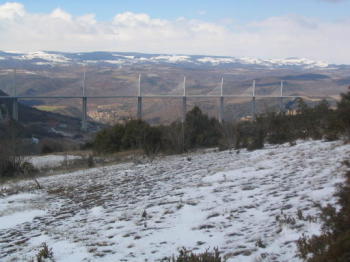
Much has been written about the recently opened Millau Viaduct in the south of France, both here and elsewhere. It takes the form of statistics: 245m from the foot of the valley to the deck, 343m from the foot of the valley to the top of the towers, 2.5km long in total. A cost of €394m to build.
Going out of my way to see the great bridges of the world is something that I do, and after reading all this I was struck by a strong urge to go and see the bridge for myself. So, I flew to Toulouse this last weekend. I rented a car, and headed for Millau. I was in no hurry. I stopped for a pleasant lunch in Albi, and rather than going up the main road, I then wound along the litte roads following the Tarn valley. One thing became obvious quickly. The Tarn valley is a huge gash through the south of France, going for hundreds of kilometres. There was clearly no easy way to build a motorway across it, anywhere. The immensity of the new viaduct was clearly out of necessity.
I had some thoughts of following the Tarn river valley all the way from Albi to Millau, with the idea that I would appreciate the scale of the valley, finally glimpse the viaduct in the distance when I was a few kilometres from it, (or maybe tens of kilometres, depending on the geography), and then approach it and eventually drive under it.
As it happened though, this was not quite what happened. The drive up the valley was spectacular, but it was a difficult drive, due to a narrow road (with some very lengthy narrow tunnels from an earlier era of engineering), and some awkward driving conditions. (It was very cold. Much of the river valley and even some of the road was covered in snow). And I kept stopping due to the fact that the scenery was beautiful and at times remarkable. (The small village of Ambialet, built in a truly extraordinary curve in the river, kept me for some time, as did a few other places).
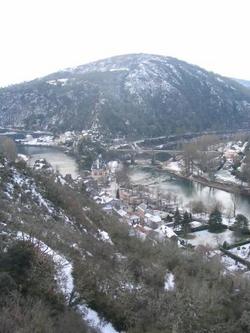
This part of France had an odd feeling of abandonment about it though. There are a lot of small villages along the river, containing beautiful old stone buildings, but these contained very few people and. I get the impression that the valley was a (fairly marginal) agricultural location a generation or two back (potatoes I would guess) but that is now gone. There are a few shops in the villages but these were mostly closed. The permanent population of these places appears to be small, and demographically not especially young. The buildings are generally in good repair, however. I get the impression that this place is highly seasonal. Tourists and owners of holiday homes probably come in summer in huge numbers for canoeing, kayaking, hiking, hang-gliding and various other activities, but not in the winter. Which is a shame, because in winter under the snow the valley was beautiful. But to attract people in winter you need to offer skiing, and this is not skiing country.
But on to the bridge. After several hours of driving slowly and stopping regularly, I realised I was a bit fatigued and it was getting late, so I ended up diverting to the B999, the main road to Millau, which detoured over a couple of ridges rather than winding up the valley.
And oddly, this turned out if anything to be better than the original choice. For as it approaches Millau the B999 swerves back into the Tarn Valley and goes under the viaduct into Millau. But it doesn’t do so at the foot of the valley but along one of the sides of the valley, probably about halfway up in altitude.
As it happened, I didn’t see the viaduct until I was quite close to it when I came around a curve in the valley. I could only initially see a small portion of it, but it was a long way above me. I drove closer, and more of the viaduct became visual. Directly under it was a visitors centre, so I parked the car and looked around me. I looked down at the river, and one of the supports of the viaduct receded a huge distance downwards. I looked to one side of the valley. The viaduct receded into the distance.
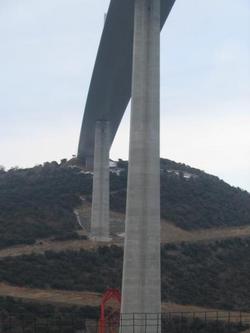
I looked the other way. The viaduct receded a long way into the distance that way, too.
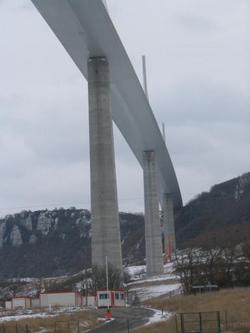
The legs of the viaduct are thick and emormous, but the deck looks somehow very slight, still somehow being held in the air when it probably shouldn’t. The materials from which this bridge has been built are vastly stronger than anything that existed even 20 years ago. I have said this before, but this is in my mind the defining characteristic of modern post materials revolution structural engineering. Structures are then, flimsy. They almost look like spider webs. The defining characteristic of industrial age engineering was bulk. But now we are in this virtuous circle of stronger and lighter materials allowing a much thinner deck, allowing the other parts of the bridge to be lighter and less substantial too, allowing still more economies elsewhere, and a rapidly dropping cost of projects like this.
And this is why this viaduct has been built. One upon a time there was only one way for a road to cross such a valley, which was to have a road going down a steep winding pass into the valley, crossing the river, and then coming up another steep winding pass on the other side. And this isn’t compatible with a motorway.
To build a straight motorway across such a valley there are two options: you dig tunnels through the cliffs on either side of the river to bring the road down to something close to river level and have a low level bridge, or you build an immense high bridge. Until recently, the cost of both options was prohibitive. Building tunnels probably still is. But due to the materials revolution the cost of a high bridge has been plummeting.
And here is the deal. Given the immensity and magnificence of the structure, the €394m that the viaduct cost to build actually wasn’t very much. Given that this is the main road from Paris to the south-west of France and to Spain, one feels that toll collection will pay off the construction cost fairly easily, even if the toll (€6.50 in summer, and €4.90 at other times of year) seems cheap.
In any event, I drove into Millau, stopping at a vantage point for another view.
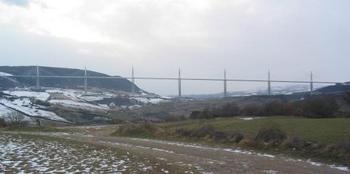
But to really get an impression of the size of this thing, it’s worth standing at the very bottom, as I did the next morning. This is high. (It’s unfortunately very difficult to take a photograph that captures both the length and the height of the bridge. It tends to be one or the other.
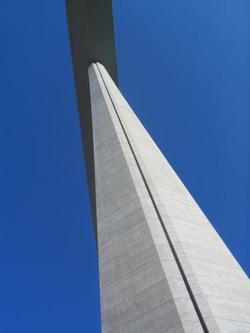
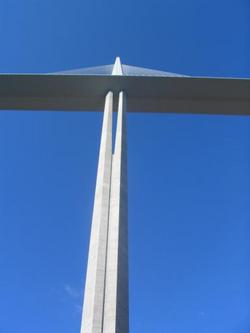
It’s easy to make smaller structures look like this with a camera and the right lens, but I am not doing this. If anything, these photographs understate the scale of the bridge. I actually took these photographs from the bottom of the bridge at around 10am on Sunday morning. As I was standing below the bridge, it appeared to start raining. This was odd, as the sky was completely clear. It took me some time to figure out that the “rain” was in fact overnight frost that was melting on the bridge way way above me and that was falling onto the floor of the valley.
But of course a bridge needs to be crossed. I like to walk across bridges, but it is not really possible with this one. It is long, and the starting and finishing points are too inaccessible. So I paid the toll, and drove over it. No doubt I broke several French laws by taking photographs while I was driving, but I did.
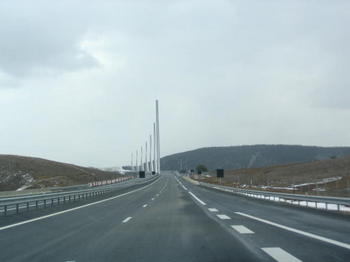
The towers and cable stays are surprisingly small given the size of the bridge. Also, on most cable stayed bridges the stays connect the towers to both edges of the bridge. Here, there are a single set of stays connecting to towers to the median strip between the two traffic ways. The deck is clearly stronger and more rigid than decks were even five or ten years ago.
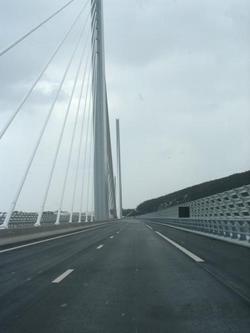
And to make sure people are not spooked by the height that they are travelling above the valley (and presumably to also stop people from jumping) the barriers at the edge of the bridge are pretty substantial.
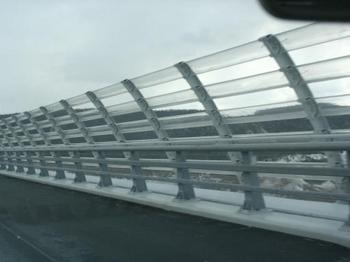
Impressive, yes, but get used to this kind of thing. Of the various computer driven technological revolutions that have been occuring in recent years, the revolution in materials is one of the most important and yet this one has received less publicity than most. Which is a shame, as this is the one that is about our control of the physical world. Architecture has become more playful in recent years, very much because engineers are suddenly less constrained by the tolerances of materials than they were. Structures of unprecedented size and length are becoming possible, at dramatically reduced costs. Some of the structures we will see in the next twenty or thirty years will boggle the mind. It’s a very exciting time to be alive.




I’d be willing to bet that another function of those barriers is aerodynamic. Big structures like that in valleys like that are sometimes subject to pretty impressive lateral pressure from the wind, and no civil engineer wants to design the next Tacoma Narrows Bridge (which got nicknamed “Galloping Gertie”).
Congratulations on the pix Michael, especially the very first one, with the snow on the mountains, and the ones looking straight up.
Cool indeed.
Now, about that one in Japan, the longest single span bridge in the world, where they had the earthquake, yet even though it was only two towers and the cables when the quake struck, they stayed up and they then modified the design to deal with the towers having moved apart a little, and finished it. Fancy a trip there?
It was on TV last night is how I know all this. Normally facts of that kind slip away from me, and these ones soon will also.
Brian: Telling people how the Akashi Kaikyo Bridge was intended to have a span of 1991 metres but that it ended up being 1992 metres because of the earthquake has been one of my favourite stories for a while. Are you sure you didn’t also hear this from me?
And of course I would like to go and see it. It’s a little far to go just for the bridge though. I have been trying to contrive a stopover in Osaka on the way to somewhere else for this very purpose for a while. I almost made it in 2003, but alas there weren’t any seats on the plane and I ended up going to Tokyo instead.
Michael,
You’re quite correct about the advances in building materials. Believe it or not, there’s a third, and somewhat larger, Narrows Bridge currently under construction in Tacoma—too much traffic for the current bridge to handle, don’tcha know—and this time they’re building it out of concrete which they say is both cheaper and stronger than the steel used in the current and previous bridges. (Video simulation here)
Sadly, the process of rigged voting and government arrogance that got the new bridge approved would make any Samizdatista weep.
Forget materials, what we want to know is did you gob or throw something off the bridge and how long did it take to hit the ground?
Stunning. Thank you Michael. The commentary was illuminating.
Bravo, bravo, bravo. A great post, and it even lured den Beste to post.
Many thanks,
Does this mean that a Channel Bridge will be affordable after the terrorists make the tunnel unusable?
I appreciate the tremendous engineering feat this bridge represents, but I think it is a hideous eyesore, and the more I look at it the more I hate it. It doesn’t blend in with its surroundings. It simply doesn’t connect with people emotionally like other famous bridges around the world do.
The use of concrete is part of the problem – concrete is usually a bland flat surface with no color. Most people prefer structures that have color and have a “texture” of some kind. Think of the Golden Gate Bridge, and how perfectly it fits into its surroundings.
The Swiss have been able to build massive concrete bridges that overcome the aesthetic limitations of concrete. Too bad the architects of this bridge didn’t learn some lessons from the Swiss.
Michael,
I must disagree with Lou–am struck by the magnificence of this viaduct and by your excellent pictures. I think the snow in the pictures hightlights the stark, whiteness of the concrete in the same way the dry brown hills contrasted with it when the bridge opened last fall.
To think that the French built it on time and on budget however is particularly galling considering the huge and costly mess the California state government is making of the replacement of the eastern span of the San Francisco Oakland Bay Bridge. Perhaps they need to consider a higher toll. You said:
That translates to about $7.00 to $9.00 US which wou357ld cause a revolution considering commuters don’t want to pay $5.00 to cross the Bay Bridge! Although to be fair the comparison isn’t apt. Most people who drive the Bay Bridge do so every day. The Millau Viaduct is probably driven a couple of times a summer by vacationers.
If you are ever in San Francisco, Michael look me up. I’d love to walk the GG Bridge with you, and you could check out the monstrous creation that is aborning between Oakland and Treasure Island!
Concrete? Sorry fellows, the bridge deck and everything above it is painted steel. They wanted it to be highly visible.
And I can’t believe the 100% private funding element was overlooked by Libertarians.
“Concrete? Sorry fellows, the bridge deck and everything above it is painted steel.”
HelenW is right. Too thin and delicate for concrete. Concrete is a clumsy, bulky and ugly material.
Why they painted it grey is beyond me. Green would have been much nicer. Or a mixture of green and sky-blue. Or something more colorful. They could have hired Agam to consult on the colors.
Why have engineers no feeling for color, and all they make is grey ?
Jacob, engineers gave the world beige. What more could you ask for?
If you like walking bridges, try the Humber Bridge near Hull. It’s a great bridge, and if you like obscure info, the piers are about 2″ (5cm) wider at the top than at the base to account for the worlds curvature.
On another note, it’s good to discover we’re not the only bridge fans.